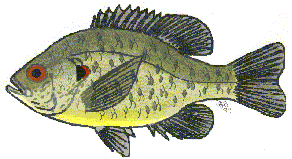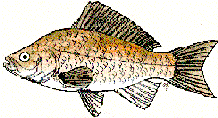| Bluegill-Short,deep-bodied fish usually with parallel vertical bars on the sids. Has a small mouth. Source of its name is the distinctive black or dark blue gill flap. Bluegill occasionally reach large size ( Arizona record: 3 lbs. 5 oz. ), but overpopulate and become stunted. Anglers can help prevent this by keeping all they catch.Bluegill are easily caught by using earth worms, meal worms or bread on No. 10 or smaller hook with a bobber. Will strike small jigs or flies. .......No creel limit Average size: 4-8 inches |
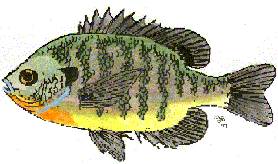 |
| Largemouth Bass- Longer and not as deep-bodied as other sunfish. Dark green on top shading to white on the belly. There is a wide, dark mottled bar along the side. Feeds almost entirely on other fish. Can be caught using lures that imitate natural prey - flies, poppers, plugs, spoons, plastic worms - or natural bait - crayfish, worms, minnows. Fish around rock piles, points and sumerged objects at dawn or dusk. Lunkersfrom 3-8 pounds are sometimes taken. Largemouth bass help control overpopulated, stunted sunfish. Hardy, they may be caught and released many times. ... Daily bag limit is 4 fish that must be a minimum of 13 inches, except for Papago Ponds # 1-3 were the limit is 1 fish that must be a minimum of 13 inches. Average size 10-15 inches. |
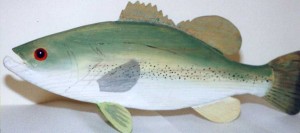 |
| Crappie - Flat - bodied fish with large dorsal and anal fins. Crappie mouths are large and the head lengths are grater than other sunfish. Body is silvery white and speckled with dark spots across the sids and fins.Feeds mostly on threadfin shad and other small fish. Often caught on small minnows, worms and jigs. Average size: 6-11 inches. No creel limit. |
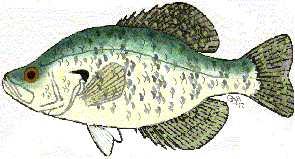 |
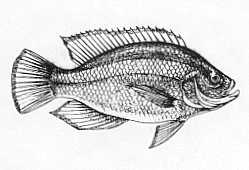 |
Tilapia - Similar to bluegill and sunfish, execpt no dark gill flap, large - headed, large mouth, with "broken" lateral line on sides. Coloration highly variable, but body tending to be olivaceous and red or iridescent blue tinges helpful in their control. Intolerant of cold water temperatures - large nimbers may die during cold winter months. Tilapia occasionally reach sizes from 1-2 pounds, but are very prolific and overpopulate and become stunted. Higly competitive with bluegill and largemouth bass. Anglers can help prevent this by keeping all they catch.Good tasting. Tilapia are caught by using small earth worms or meal worms on # 8 or smaller hook with a bobber. Will strike small jigs or flies. Average size: 5-10 inches. No creel limite. |
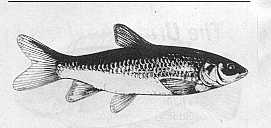 |
White Amur ( grass carp ) - Similar to common carp only in color ( brassy yellow ) and large scales, Notable differences include no barbels on bony mouth, no spine on a short dorsal fin or anal fin, more elongated, tail darher and more deeply forked. These fish are highly effective biological controls of nuisance weed and algae problems and were stocked for these purposes. Lakes containing white amur are posted with advisory signs. White amur can consume more than their body weight in aquatic weeds each day. Although vegetarians, white amur will occasionally tahe various baits.Good fighters. Anglers should exercise care to ensuresafe release of these fish. A state record 40 pounder was caught in 1998 from Encanto Lake. Average size: 15-30 inches. Daily creel limit is 1 fish that must be a minimum of 30 inches. |
| Carp - Anoften overlooked food and sport fish. Carp have large scales, two small barbels on each side of fleshy mouth, and a large sawtoothed spine at the front of a long, single dorsal fin and the anal fin. Color is brassy yellow or gold. Use worms, corn or dough balls made with bread, cornmeal or Wheaties with various flavors ( such as liver or anise ) added, and fish on bottom. Catches of 8-15 pounders not uncommon. Good fighters. Tasty when smoked. Average size 15-22 inches. No creel limite. |
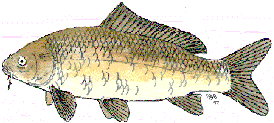 |
| Channel Catfish - These fish have spines in the dorsal and pectoral fins, long barbels about the mouth, and an adipose fin. Body is scaleless amd the tail is deeply forked. Younger fish are silvery with black spots. Older fish are blue-black above wiyh white bellies. Most offten caught with worms, liver, shrimp, hot dogs or prepared "stink" baits fished on the bottom at dusk, at night, or at dawn. Use sliding sinker, No.2-6 hook. "Cats" stocked in Designated Urban Lakes average 1 1/2lbs., but 3-6 lb. lunkers are not uncommon. Bag and possession limit 4 |
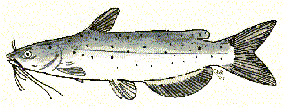 |
| Rainbow Trout - Arizona's most popular trout has very fine scales, an adipose fine and a silvery body that goes from dark olive to black on top to silvery white on the belly. Body and fins are spotted. Sides often have a horizontal pink streak, hence its name. A coldwater fish, the rainbow trout does not survive through the hot summer months in urban lakes. Can be caught on salmon eggs, Power Bait, corn, worms and cheese using No.10 or 12 hook and small weight or with a bobber. Also strikes small spinners and other flashing lures as well as dry flies and nymph patterns. Designated Urban Lakes are stocked with rainbow trout averaging over 1/3 pounds each. Occasional catches of 2 -3 lb. fish occur. Stocked every other week from November - March Average size: 9 - 14 inches. Bag and possession limit 4 for licensed anglers and 2 for unlicensed juveniles and blind residents. |
 |








